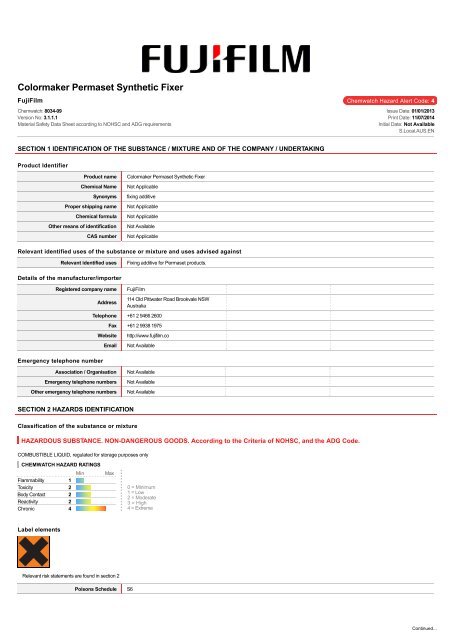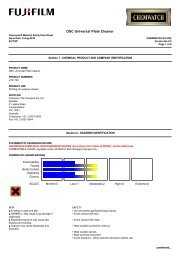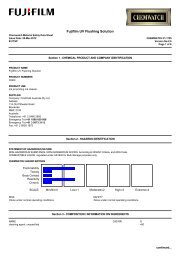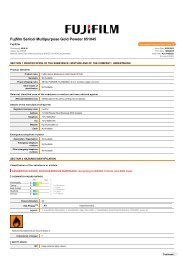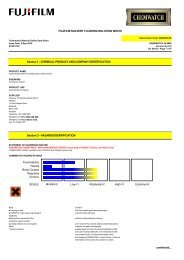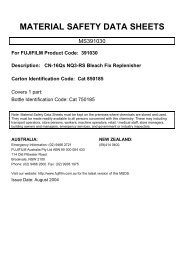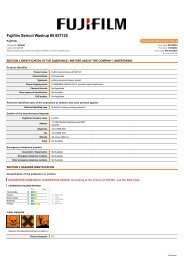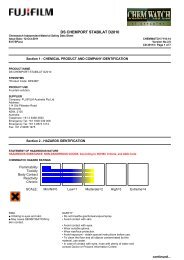Colormaker Permaset Synthetic Fixer
Colormaker Permaset Synthetic Fixer
Colormaker Permaset Synthetic Fixer
Create successful ePaper yourself
Turn your PDF publications into a flip-book with our unique Google optimized e-Paper software.
Chemwatch: 8034-09Version No: 3.1.1.1Page 2 of 10<strong>Colormaker</strong> <strong>Permaset</strong> <strong>Synthetic</strong> <strong>Fixer</strong>Issue Date: 01/01/2013Print Date: 11/07/2014R20/21/22Harmful by inhalation, in contact with skin and if swallowed.R36/38 Irritating to eyes and skin.R52/53 Harmful to aquatic organisms, may cause long-term adverse effects in the aquatic environment.Risk Phrases [1]R68(3)R43R40(3)R19Possible risk of irreversible effects.May cause SENSITISATION by skin contact.Limited evidence of a carcinogenic effect.May form explosive peroxides.Legend:1. Classified by Chemwatch; 2. Classification drawn from HSIS ; 3. Classification drawn from EC Directive 1272/2008 - Annex VIIndication(s) of dangerXnSAFETY ADVICES07S09S13S18S23S25S26S29S35S36S37S39S40S46S51S53S56S57S64Keep container tightly closed.Keep container in a well ventilated place.Keep away from food, drink and animal feeding stuffs.Handle and open container with care.Do not breathe gas/fumes/vapour/spray.Avoid contact with eyes.In case of contact with eyes, rinse with plenty of water and contact Doctor or Poisons Information Centre.Do not empty into drains.This material and its container must be disposed of in a safe way.Wear suitable protective clothing.Wear suitable gloves.Wear eye/face protection.To clean the floor and all objects contaminated by this material, use water.If swallowed, seek medical advice immediately and show this container or label.Use only in well ventilated areas.Avoid exposure - obtain special instructions before use.Dispose of this material and its container at hazardous or special waste collection point.Use appropriate container to avoid environmental contamination.If swallowed, rinse mouth with water (only if the person is conscious).Other hazardsCumulative effects may result following exposure*.May be harmful to the foetus/ embryo*.May possibly affect fertility*.Vapours potentially cause drowsiness and dizziness*.SECTION 3 COMPOSITION / INFORMATION ON INGREDIENTSSubstancesSee section below for composition of MixturesMixturesCAS No %[weight] Name3089-11-0 30-60 2,4,6-tris[bis(methoxymethyl)amino]-1,3,5-triazine111-76-2 25 ethylene glycol monobutyl ether50-00-0 0.25 formaldehyde67-56-1 0.25 methanol7732-18-5 10-30 waterSECTION 4 FIRST AID MEASURESDescription of first aid measuresEye ContactIf this product comes in contact with the eyes:Wash out immediately with fresh running water.Continued...
Chemwatch: 8034-09Version No: 3.1.1.1Page 4 of 10<strong>Colormaker</strong> <strong>Permaset</strong> <strong>Synthetic</strong> <strong>Fixer</strong>Issue Date: 01/01/2013Print Date: 11/07/2014Proparacaine hydrochloride should be used to assist eye irrigation.BRONSTEIN, A.C. and CURRANCE, P.L.EMERGENCY CARE FOR HAZARDOUS MATERIALS EXPOSURE: 2nd Ed. 1994SECTION 5 FIREFIGHTING MEASURESExtinguishing mediaAlcohol stable foam.Dry chemical powder.BCF (where regulations permit).Carbon dioxide.Special hazards arising from the substrate or mixtureFire IncompatibilityAvoid contamination with oxidising agents i.e. nitrates, oxidising acids, chlorine bleaches, pool chlorine etc. as ignition may resultAdvice for firefightersFire FightingFire/Explosion HazardAlert Fire Brigade and tell them location and nature of hazard.Wear full body protective clothing with breathing apparatus.Prevent, by any means available, spillage from entering drains or water course.Use water delivered as a fine spray to control fire and cool adjacent area.Combustion products include:Combustible.Slight fire hazard when exposed to heat or flame.Heating may cause expansion or decomposition leading to violent rupture of containers.On combustion, may emit toxic fumes of carbon monoxide (CO).SECTION 6 ACCIDENTAL RELEASE MEASURESPersonal precautions, protective equipment and emergency proceduresMinor SpillsMajor SpillsRemove all ignition sources.Clean up all spills immediately.Avoid breathing vapours and contact with skin and eyes.Control personal contact with the substance, by using protective equipment.Clear area of personnel and move upwind.Alert Fire Brigade and tell them location and nature of hazard.Wear full body protective clothing with breathing apparatus.Prevent, by all means available, spillage from entering drains or water courses.Personal Protective Equipment advice is contained in Section 8 of the MSDS.SECTION 7 HANDLING AND STORAGEPrecautions for safe handlingSafe handlingOther informationDO NOT allow clothing wet with material to stay in contact with skinThe tendency of many ethers to form explosive peroxides is well documented. Ethers lacking non-methyl hydrogen atoms adjacent to the ether linkare thought to be relatively safeDO NOT concentrate by evaporation, or evaporate extracts to dryness, as residues may contain explosive peroxides with DETONATIONpotential.Any static discharge is also a source of hazard.Before any distillation process remove trace peroxides by shaking with excess 5% aqueous ferrous sulfate solution or by percolationthrough a column of activated alumina.Store in original containers.Keep containers securely sealed.No smoking, naked lights or ignition sources.Store in a cool, dry, well-ventilated area.Conditions for safe storage, including any incompatibilitiesSuitable containerStorage incompatibilityMetal can or drumPackaging as recommended by manufacturer.Check all containers are clearly labelled and free from leaks.Alcoholsare incompatible with strong acids, acid chlorides, acid anhydrides, oxidising and reducing agents.reacts, possibly violently, with alkaline metals and alkaline earth metals to produce hydrogenreact with strong acids, strong caustics, aliphatic amines, isocyanates, acetaldehyde, benzoyl peroxide, chromic acid, chromium oxide,dialkylzincs, dichlorine oxide, ethylene oxide, hypochlorous acid, isopropyl chlorocarbonate, lithium tetrahydroaluminate, nitrogen dioxide,pentafluoroguanidine, phosphorus halides, phosphorus pentasulfide, tangerine oil, triethylaluminium, triisobutylaluminiumshould not be heated above 49 deg. C. when in contact with aluminium equipment*Glycol ethers may form peroxides under certain conditions; the potential for peroxide formation is enhanced when these substances areused in processes such as distillation where they are concentrated or even evaporated to near-dryness or dryness; storage under anitrogen atmosphere is recommended to minimise the possible formation of highly reactive peroxidesNitrogen blanketing is recommended if transported in containers at temperatures within 15 deg C of the flash-point and at or above theContinued...
Chemwatch: 8034-09Version No: 3.1.1.1Page 5 of 10<strong>Colormaker</strong> <strong>Permaset</strong> <strong>Synthetic</strong> <strong>Fixer</strong>Issue Date: 01/01/2013Print Date: 11/07/2014flash-point - large containers may first need to be purged and inerted with nitrogen prior to loadingIn the presence of strong bases or the salts of strong bases, at elevated temperatures, the potential exists for runaway reactions.Contact with aluminium should be avoided; release of hydrogen gas may result- glycol ethers will corrode scratched aluminium surfaces.PACKAGE MATERIAL INCOMPATIBILITIESNot AvailableSECTION 8 EXPOSURE CONTROLS / PERSONAL PROTECTIONControl parametersOCCUPATIONAL EXPOSURE LIMITS (OEL)INGREDIENT DATASource Ingredient Material name TWA STEL Peak NotesAustralia Exposure Standardsethylene glycolmonobutyl ether2-Butoxyethanol96.9mg/m3 /20 ppm242mg/m3 /50 ppmNotAvailableSkAustralia Exposure Standards formaldehyde Formaldehyde1.2mg/m3 /1 ppm2.5mg/m3 /2 ppmNotAvailableSen; Documentation for the substances with this footnote canbe found in the 5th Edition of the ACGIH documentation of thethreshold limit values and biological exposure indices.For allother substances with 'H' in Column 7 the documentation canbe found in the 6th Edition of the ACGIH documentation of thethreshold limit values and biological exposure indices.Australia Exposure Standards methanol Methyl alcohol262mg/m3 /200 ppm328mg/m3 /250 ppmNotAvailableSkEMERGENCY LIMITSIngredient TEEL-0 TEEL-1 TEEL-2 TEEL-3ethylene glycol monobutyl ether 50 ppm 50 ppm 100 ppm 700 ppmformaldehyde 0.3 ppm 0.9 ppm 14 ppm 56 ppmmethanol 200 ppm 530 ppm 2100 ppm 7200 ppmwater 500 ppm 500 ppm 500 ppm 500 ppmIngredient Original IDLH Revised IDLH2,4,6-tris[bis(methoxymethyl)amino]-1,3,5-triazineNot AvailableNot Availableethylene glycol monobutyl ether 700 ppm 700 [Unch] ppmformaldehyde 30 ppm 20 ppmmethanol 25,000 ppm 6,000 ppmwater Not Available Not AvailableExposure controlsAppropriate engineering controlsEngineering controls are used to remove a hazard or place a barrier between the worker and the hazard. Well-designed engineering controlscan be highly effective in protecting workers and will typically be independent of worker interactions to provide this high level of protection.The basic types of engineering controls are:Process controls which involve changing the way a job activity or process is done to reduce the risk.Enclosure and/or isolation of emission source which keeps a selected hazard "physically" away from the worker and ventilation that strategically"adds" and "removes" air in the work environment.Personal protectionEye and face protectionSkin protectionHands/feet protectionBody protectionSafety glasses with side shields.Chemical goggles.Contact lenses may pose a special hazard; soft contact lenses may absorb and concentrate irritants. A written policy document, describingthe wearing of lenses or restrictions on use, should be created for each workplace or task.See Hand protection belowThe selection of suitable gloves does not only depend on the material, but also on further marks of quality which vary from manufacturer tomanufacturer. Where the chemical is a preparation of several substances, the resistance of the glove material can not be calculated in advanceand has therefore to be checked prior to the application.The exact break through time for substances has to be obtained from the manufacturer of the protective gloves and.has to be observed whenmaking a final choice.Suitability and durability of glove type is dependent on usage.See Other protection belowContinued...
Chemwatch: 8034-09Version No: 3.1.1.1Page 6 of 10<strong>Colormaker</strong> <strong>Permaset</strong> <strong>Synthetic</strong> <strong>Fixer</strong>Issue Date: 01/01/2013Print Date: 11/07/2014Other protectionThermal hazardsPrior to each exit from an area containing confirmed human carcinogens, employees should be required to remove and leave protectiveclothing and equipment at the point of exit and at the last exit of the day, to place used clothing and equipment in impervious containers atthe point of exit for purposes of decontamination or disposal. The contents of such impervious containers must be identified with suitablelabels. For maintenance and decontamination activities, authorized employees entering the area should be provided with and required towear clean, impervious garments, including gloves, boots and continuous-air supplied hood.Prior to removing protective garments the employee should undergo decontamination and be required to shower upon removal of thegarments and hood.Not AvailableRecommended material(s)GLOVE SELECTION INDEXGlove selection is based on a modified presentation of the:"Forsberg Clothing Performance Index".The effect(s) of the following substance(s) are taken into account in the computergeneratedselection:<strong>Colormaker</strong> <strong>Permaset</strong> <strong>Synthetic</strong> <strong>Fixer</strong>MaterialBUTYLNEOPRENE* CPI - Chemwatch Performance IndexA: Best SelectionB: Satisfactory; may degrade after 4 hours continuous immersionC: Poor to Dangerous Choice for other than short term immersionNOTE: As a series of factors will influence the actual performance of the glove, a finalselection must be based on detailed observation. -* Where the glove is to be used on a short term, casual or infrequent basis, factors such as"feel" or convenience (e.g. disposability), may dictate a choice of gloves which might otherwisebe unsuitable following long-term or frequent use. A qualified practitioner should be consulted.CPIAARespiratory protectionType BAX-P Filter of sufficient capacity. (AS/NZS 1716 & 1715, EN 143:2000 & 149:2001, ANSIZ88 or national equivalent)Where the concentration of gas/particulates in the breathing zone,approaches or exceeds the "Exposure Standard" (or ES), respiratoryprotection is required.Degree of protection varies with both face-piece and Class of filter;the nature of protection varies with Type of filter.RequiredMinimumProtectionFactorup to 5 x ESHalf-FaceRespiratorBAX-AUS /Class 1 P2Full-FaceRespirator-Powered AirRespiratorBAX-PAPR-AUS /Class 1 P2up to 25 x ES Air-line* BAX-2 P2 BAX-PAPR-2 P2up to 50 x ES - BAX-3 P2 -50+ x ES - Air-line** -^ - Full-faceA(All classes) = Organic vapours, B AUS or B1 = Acid gasses, B2 =Acid gas or hydrogen cyanide(HCN), B3 = Acid gas or hydrogencyanide(HCN), E = Sulfur dioxide(SO2), G = Agricultural chemicals,K = Ammonia(NH3), Hg = Mercury, NO = Oxides of nitrogen, MB =Methyl bromide, AX = Low boiling point organic compounds(below65 degC)SECTION 9 PHYSICAL AND CHEMICAL PROPERTIESInformation on basic physical and chemical propertiesAppearanceClear liquid; mixes with water.Physical state Liquid Relative density (Water = 1) 1.07Odour Not Available Partition coefficient n-octanol / water Not AvailableOdour threshold Not Available Auto-ignition temperature (°C) Not AvailablepH (as supplied) 5.0 Decomposition temperature Not AvailableMelting point / freezing point (°C) Not Available Viscosity (cSt) Not AvailableInitial boiling point and boiling range(°C)100 Molecular weight (g/mol) Not ApplicableFlash point (°C) 64 Taste Not AvailableEvaporation rate Not Available Explosive properties Not AvailableFlammability Combustible. Oxidising properties Not AvailableUpper Explosive Limit (%) Not Available Surface Tension (dyn/cm or mN/m) Not AvailableLower Explosive Limit (%) Not Available Volatile Component (%vol) Not AvailableVapour pressure (kPa) Not Available Gas group Not AvailableSolubility in water (g/L) Miscible pH as a solution(1%) Not AvailableVapour density (Air = 1) Not Available VOC g/L Not AvailableSECTION 10 STABILITY AND REACTIVITYReactivity See section 7Chemical stabilityUnstable in the presence of incompatible materials.Product is considered stable.Hazardous polymerisation will not occur.Continued...
Chemwatch: 8034-09Version No: 3.1.1.1Page 10 of 10<strong>Colormaker</strong> <strong>Permaset</strong> <strong>Synthetic</strong> <strong>Fixer</strong>Issue Date: 01/01/2013Print Date: 11/07/2014methanol(67-56-1) is found on thefollowing regulatory listswater(7732-18-5) is found on thefollowing regulatory listsNational List of Candidates for Substitution – Norway","Australia Drinking Water Guideline Values For Physical and ChemicalCharacteristics","International Agency for Research on Cancer (IARC) - Agents Classified by the IARC Monographs","Australia Inventory ofChemical Substances (AICS)","Belgium Federal Public Service Mobility and Transport, Regulations concerning the International Carriage ofDangerous Goods by Rail - Table A: Dangerous Goods List - RID 2013 (Dutch)","International Numbering System for Food Additives","Australia- Victoria Drugs, Poisons and Controlled Substances (Precursor Chemicals) Regs 2007 - Schedule 1 - Precursor Chemicals andQuantities","International Chemical Secretariat (ChemSec) SIN List (*Substitute It Now!)","International Society of Automotive Engineers (SAE)Declarable Substances Chemical List - ARP9536","Australia - New South Wales - Work Health and Safety Regulation 2011 Restrictedhazardous chemicals","Australia National Pollutant Inventory","UNECE - Kiev Protocol on Pollutant Release and Transfer Registers - AnnexII","Australia Dangerous Goods Code (ADG Code) - Goods Too Dangerous To Be Transported","WHO Guidelines for Drinking-water Quality -Chemicals for which guideline values have not been established","Australia - Australian Capital Territory - Environment Protection Regulation:Pollutants entering waterways taken to cause environmental harm - Domestic water supply quality","OECD Existing ChemicalsDatabase","Sigma-AldrichTransport Information","Australia High Volume Industrial Chemical List (HVICL)","Australia Illicit DrugPrecursors/Reagents - Category II","United Nations Recommendations on the Transport of Dangerous Goods Model Regulations(Spanish)","Australia Dangerous Goods Code (ADG Code) - Dangerous Goods List","Australia Work Health and Safety Regulations 2011 -Hazardous chemicals at major hazard facilities and their threshold quantity","Australia Standard for the Uniform Scheduling of Medicines andPoisons (SUSMP) - Appendix E (Part 2)","GESAMP/EHS Composite List - GESAMP Hazard Profiles","International Air Transport Association(IATA) Dangerous Goods Regulations","Australia Hazardous Substances Information System - Consolidated Lists","Australia - QueenslandWork Health and Safety Regulation - Hazardous chemicals at major hazard facilities (and their threshold quantity)","Australia Work Health andSafety Regulations 2011 - Restricted hazardous chemicals","Australia - New South Wales Hazardous Substances Prohibited for SpecificUses","International Fragrance Association (IFRA) Survey: Transparency List","IMO IBC Code Chapter 17: Summary of minimumrequirements","Australia Standard for the Uniform Scheduling of Medicines and Poisons (SUSMP) - Schedule 6","Acros Transport Information""Australia Standard for the Uniform Scheduling of Medicines and Poisons (SUSMP) - Schedule 5","International Council of ChemicalAssociations (ICCA) - High Production Volume List","IMO MARPOL 73/78 (Annex II) - List of Noxious Liquid Substances Carried inBulk","International Maritime Dangerous Goods Requirements (IMDG Code)","Australia Standard for the Uniform Scheduling of Medicines andPoisons (SUSMP) - Appendix F (Part 3)","IMDG Code - Medical First Aid Guide for use in accidents involving Dangerous Goods (MFAG) -Appendix 15 List Of Substances","International Maritime Dangerous Goods Requirements (IMDG Code) - Substance Index","AustraliaExposure Standards","Australia - Tasmania - Work Health and Safety Regulations 2012 - Restricted hazardous chemicals","Australia - NorthernTerritories Work Health and Safety National Uniform Legislation Regulations- Restricted hazardous chemicals","Australia FAISD Handbook -First Aid Instructions, Warning Statements, and General Safety Precautions","FisherTransport Information","IMO MARPOL 73/78 (Annex II) -List of Other Liquid Substances","Australia Dangerous Goods Code (ADG Code) - List of Emergency Action Codes","United NationsConsolidated List of Products Whose Consumption and/or Sale Have Been Banned, Withdrawn, Severely Restricted or Not Approved byGovernments","United Nations Recommendations on the Transport of Dangerous Goods Model Regulations (English)","OECD List of HighProduction Volume (HPV) Chemicals","Australia - South Australia - Work Health and Safety Regulations 2012 - Restricted hazardouschemicals","Australia - Queensland Work Health and Safety Regulation - Restricted hazardous chemicals","OSPAR National List of Candidatesfor Substitution – Norway","Australia Inventory of Chemical Substances (AICS)","Belgium Federal Public Service Mobility and Transport,Regulations concerning the International Carriage of Dangerous Goods by Rail - Table A: Dangerous Goods List - RID 2013(Dutch)","Australia - New South Wales - Work Health and Safety Regulation 2011 Restricted hazardous chemicals","Australia National PollutantInventory","OECD Existing Chemicals Database","Sigma-AldrichTransport Information","Australia High Volume Industrial Chemical List(HVICL)","United Nations Recommendations on the Transport of Dangerous Goods Model Regulations (Spanish)","Australia DangerousGoods Code (ADG Code) - Dangerous Goods List","Australia Standard for the Uniform Scheduling of Medicines and Poisons (SUSMP) -Appendix E (Part 2)","GESAMP/EHS Composite List - GESAMP Hazard Profiles","International Air Transport Association (IATA) DangerousGoods Regulations","Australia Hazardous Substances Information System - Consolidated Lists","Australia Work Health and Safety Regulations2011 - Restricted hazardous chemicals","Australia - New South Wales Hazardous Substances Prohibited for Specific Uses","IMO IBC CodeChapter 17: Summary of minimum requirements","Acros Transport Information","Australia Standard for the Uniform Scheduling of Medicinesand Poisons (SUSMP) - Schedule 6""OECD List of High Production Volume (HPV) Chemicals","OSPAR National List of Candidates for Substitution – Norway","WHO Model List ofEssential Medicines - Adults","Australia Inventory of Chemical Substances (AICS)","IMO IBC Code Chapter 18: List of products to which theCode does not apply","Sigma-AldrichTransport Information","Australia High Volume Industrial Chemical List (HVICL)","International FragranceAssociation (IFRA) Survey: Transparency List"SECTION 16 OTHER INFORMATIONOther informationClassification of the preparation and its individual components has drawn on official and authoritative sources as well as independent review by the Chemwatch Classification committee usingavailable literature references.A list of reference resources used to assist the committee may be found at:www.chemwatch.net/referencesThe (M)SDS is a Hazard Communication tool and should be used to assist in the Risk Assessment. Many factors determine whether the reported Hazards are Risks in the workplace or othersettings. Risks may be determined by reference to Exposures Scenarios. Scale of use, frequency of use and current or available engineering controls must be considered.This document is copyright. Apart from any fair dealing for the purposes of private study, research, review or criticism, as permitted under the Copyright Act, no part may be reproduced by anyprocess without written permission from CHEMWATCH. TEL (+61 3) 9572 4700.end of SDS


